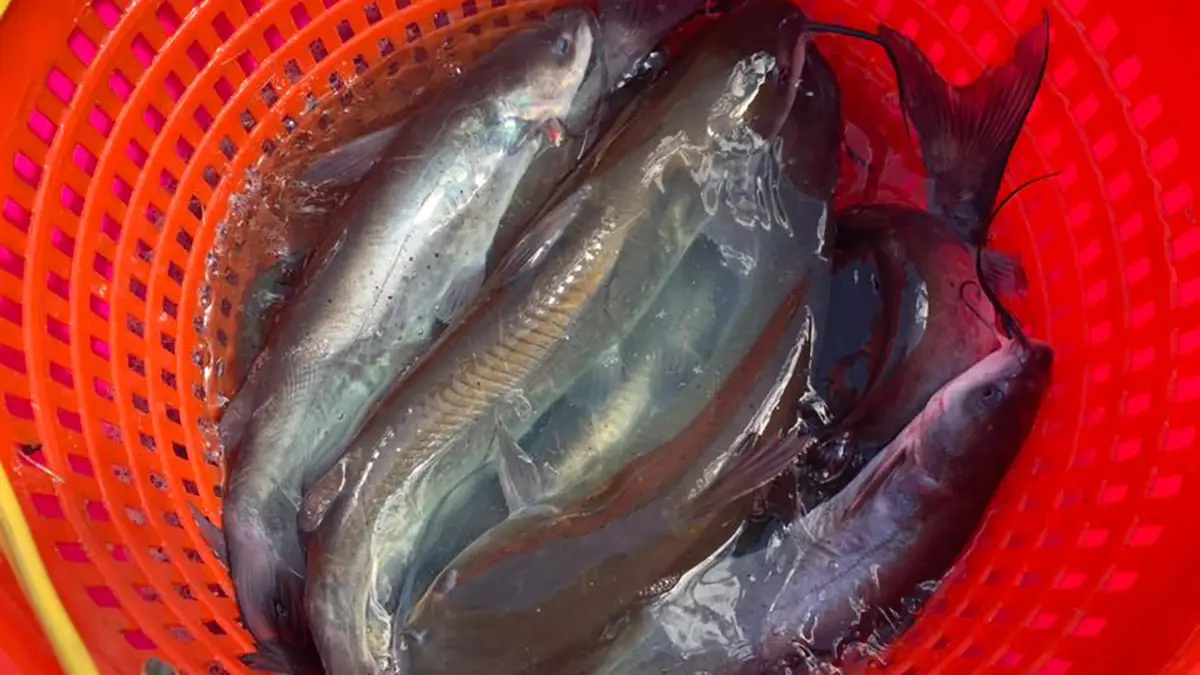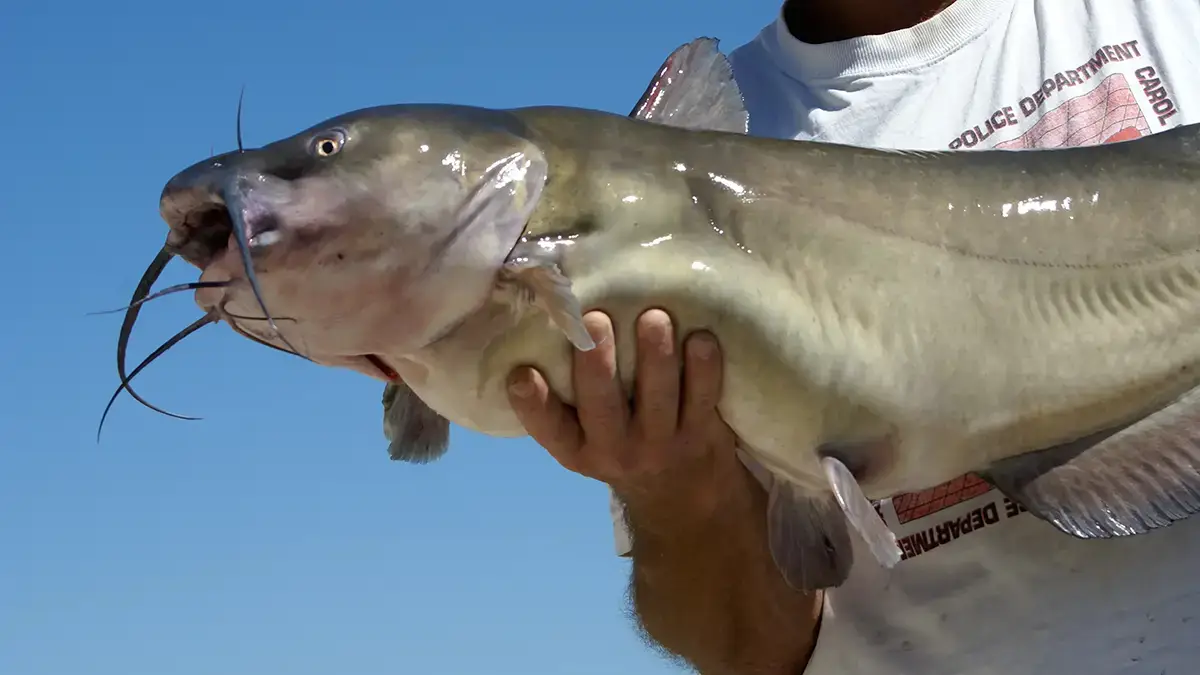For several decades channel catfish have been the king of the aquaculture industry, with hundreds of tons of fish being sold annually throughout the US. They are one of the most harvested species by anglers in both public and private water bodies. Over time the popularity of catfish has created the emerging sportfishing industry with dedicated catfish gear, catfish baits, boats outfitted specifically for targeting catfish and even catfish tournaments. You can even kayak fish for catfish!
Due to the historic importance of channel catfish for human consumption and their popularity as a sport fish they are one of the most studied species of freshwater fish and that means we have a lot of great information to share with you in this species profile for channel catfish. And hopefully our series of catfish articles will help you catch your own personal best, a state record or maybe even the next world record catfish.
Channel Cat History
Channel Catfish (Ictalurus punctatus) belong to the Ictaluridae family, which includes flathead catfish, brown bullhead, headwater catfish, and blue catfish. The Ictaluridae family contains fifty one species and is North America’s most prominent fish family.
There are other families of catfish worldwide, including the Pangasiidae which includes the Mekong giant catfish, the Siluridae which includes the Wels catfish, Callichthyidae which includes the aquarium cory catfish, and the Loricariidae which includes the armored catfish. These families are found in the species order Siluriformes which includes all catfish species found worldwide.
Channel catfish were first described by Constantine Samuel Rafinesque, in “Discoveries in Natural History, Made During a Journey Through the Western Region of the United States.” The original fish described in 1818 was from the Ohio River. The species name Ictalurus punctatus is broken into two parts, Ictalurus is a combination of Greek words that translates to fish cat referring to the prominent whiskers or barbels on the face, and punctatus is Latin for spotted a trait found in juvenile fish.
Alternative Names for Channel Catfish
The channel catfish has several common names, including willow cat, lady cat, spotted cat, fiddler, fork-tailed cat, Mississippi catfish, blue channel, speckled cat, graceful catfish, swimming tongue, river cat, sand cat, channel, and chucklehead cat.
Channel Catfish Identification
Catfish species are iconic and easily identified from other fish species. All Ictalurus species have barbels (whiskers), are lacking scales, have adipose fins, and have spined pectoral fins. Instead of scales the skin of catfish is covered in glands that secrete mucus, creating a slime layer that serves as a protective barrier against pathogens. Overall the body of Ictalurus species are generally tubular or elongated.
Mouth and Barbels
The mouth on a channel catfish is sub-terminal, meaning the upper jaw slightly overhangs the lower jaw and creates a mouth opening that points downward. There will be eight barbels around the mouth. One longer barbel on each side of the mouth, two above the mouth, and four below the mouth on the chin. Lower barbels are non pigmented in juvenile fish but slowly become darker gray in coloration. Barbels on the side of the mouth will be black to dark gray in color. None of the barbels contain spines and are harmless, they primarily serve as sense organs for locating food.
Spines
Channel catfish have single spines on the dorsal and pectoral fins. The pectoral fin spines are serrated along the backside of the spine. The tips are extremely sharp on juvenile fish and become blunt in older fish. These spines will erect perpendicular to the body when the fish becomes alarmed and can be quite painful if you are “spined” by one. The dorsal fin will contain the single spine and 6 to 7 soft rays. The pectoral fins will have a single spine and 7 to 9 soft rays.
Fins
The anal fin of channel catfish are elongated and pigmented. They contain 27 to 29 soft rays and end in a rounded edge. Pelvic fins will have 8 to 9 soft rays and one spine. The adipose fin of channel catfish is small in size and found just before the caudal peduncle. The adipose fin has no rays or spines and is fat filled. The tail of the channel catfish will be dark pigmented, with a noticeable forked appearance.
Color
The color of the channel catfish will vary throughout their lives and can be affected by water clarity, water color, depth, time or year, age, sexual maturity, and individual sex. The back and head of channel catfish can be pale blue, olive, brown, black, or gray. Their coloration will typically lighten down the body and become white to dusky gray on the stomach.
The lateral line can be evident as a straight line from behind the gills to the base of the caudal tail. Channel catfish may have black spots that develop as fingerlings and become absent with age. The fins of juvenile fish will have a distinct black margin on the tips that also fade with age.
How to Identify a Channel Catfish
To most easily identify channel catfish from blue catfish, use the anal fin. It is rounded in shape in channel cat and has a squared-edged for blue catfish. Blue catfish will have 30 to 36 rays on the anal fin while channel catfish have 27 to 29 rays. To most easily identify channel catfish from the bullhead and flathead catfish, use the caudal tail. The channel catfish has a forked tail while bullhead and flathead catfish will have a non forked square or rounded tail.
Channel Catfish Location
Channel catfish are native to North America, primarily the Gulf states and the Mississippi and Missouri River basins. Their home range extended north throughout the Great Lakes and into southern Quebec and Manitoba. To the west channel catfish could be found in Montana and Wyoming but not west of the Rocky Mountains. To the south they stretched into northern Mexico and along the entire US portion of the Gulf of Mexico. It is debated where their eastern boundary was found but most continue to support that the channel catfish did not reach the Atlantic coast, except in Florida and Georgia.
Channel catfish can now be found throughout the contiguous United States, Canada, Mexico. The popularity of channel catfish in aquaculture has led to their expansion well beyond North America. They have been established in over 25 countries including Nigeria, Russia, Japan, South Korea, Italy, the United Kingdom, Spain, Panama, Puerto Rico, Cuba, Fiji, Brazil, and even the US Hawaiian islands.
North American Channel Cat Distribution
To see the current distribution of channel catfish we have created this interactive map.
Channel’s Spawning Rituals
Channel catfish spawning begins in late spring to early summer when water temperatures are sustained above 75℉ and continues through about 85℉. Channel catfish are crevice, hole, or cave spawners. The male channel catfish will select or build a nest in a secluded dark area. Nesting sites could include undercut banks, in or under logs, under rocks, in tires, or even in buckets. Channel catfish may spawn directly on the bottom out of a cavity if they are within a highly turbid fishery.
To prepare the nest the male channel catfish will fan its tail and push water into the crevice, removing silt and exposing the hard bottom. When the nest is completed the male attracts a female, during this time other males may challenge him for the spawning location, causing male channel catfish to exhibit head wounds or scars during spawning season.
When a female enters the nest the pair will spawn for up to 6 hours. During this time multiple short duration egg and fertilization attempts are made. A female will eventually deposit all of her egg mass which could be 2,000 to 4,000 eggs per pound of body weight.
Immediately after spawning concludes the male will push the female from the spawning bed and begin aerating the eggs using his fins. At this point the male is extremely aggressive to anything entering the spawning bed and fights off all intruders. The fertilized eggs are yellow, .10 to .15 inches, and very adhesive.
The eggs hatch in 3 to 10 days depending on water temperature. Increasing or decreasing temperature by 1℉ will shorten or extend hatching time by 1 day. So at 77℉ hatching occurs at 6 days, at 75℉ hatching occurs at 8 days, and at 80℉ hatching can occur at 3 days. If was temperatures drop below 65℉ or raise above 85℉ eggs may not hatch or could result in deformed fry.
Average Size and Lifespan
Once hatched, channel catfish fry will spend the first 2 to 5 days absorbing their yolk sac. The fry will then make a long swim up to the surface to fill their swim bladders with air. Fry will then live in large schools in shallow water with abundant cover. During this time the fry are vulnerable to predation and survival rates are much lower in clear waters with high visibility.
Growth in reservoirs depends highly on the location of the fishery, fertility, temperature, and competition. First year growth can range from 3 to 6 inches, with an additional 2 to 3 inches of growth per year. Males mature at 12 inches in length which could take 2 to 3 years, females mature later at 14 inches and 3 to 5 years.
Sexual dimorphism can be found at 6 months but becomes more evident during spawning season. Males will develop heads that are wider than their body, and have swollen cranial muscles behind their eyes. Female heads will be more narrow than their body and will be smooth in shape.
In southern states or in aquaculture facilities growth rates can be much quicker than northern states or wild populations with fish reaching harvestable size of 1 1/4 to 1 1/2 pounds in 18 months. The optimal growth temperatures for channel catfish is 85 ℉ with their metabolism doubling or halving for every 18 degrees F.
At optimal growth rates feed conversion for channel catfish is 1 pound of body weight for every 1 1/2 to 2 pounds of feed consumed. In aquaculture facilities, 3,500 to 5,000 pounds of channel catfish can be raised and harvested per acre per year.
Channel catfish live 6 to 10 years in the southern parts of their range and 15-20 years in the north parts. The oldest channel catfish found in scientific research is a 40 year old fish from Canada found in the Handbook of Freshwater Fishery Biology, Kenneth Carlander 1969.
Channel’s Diet Preferences
Catfish not only have taste receptors on their barbels but also throughout their entire body. These taste receptors allow catfish to locate food items from far distances in low to no visibility. Channel catfish typically feed at the bottom of the water column but occasionally feed at the water’s surface. Due to their mouth location they must feed on the surface in a fairly vertical position or expose their heads above the water to vacuum food off the surface.
If you have ever fished for channel catfish, you know they will feed on all types of bait, they are highly omnivores in all stages of their lives. As juveniles they feed on benthic material like detritus, zooplankton, and aquatic invertebrates. As channel catfish grow their diet incorporates aquatic vegetation and terrestrial invertebrates. At 10 inches in length they incorporate fish such as minnows and crayfish. Once channel catfish have reached above 18 inches they consume 75% of their diet as fish.
Channel Catfish Habitat
Adult channel catfish can be found and adapt to almost all habitats in reservoirs, ponds, rivers, creeks, or even brackish marshes. In reservoirs throughout the day they prefer deeper cooler water moving to shallow water to feed at dusk and overnight. Often they can be found near rip rap rock, above or below water control gates, at standing timber, and around emergent vegetation. They commonly can be found at the base of trees with roosting birds. In water with current they will often be found in deeper pools or behind current breaks.
Water quality can be a limiting factor to channel catfish abundance. They have an upper temperature limit of 98 to 100℉. Their growth slows at dissolved oxygen of 4 ppm, they avoid dissolved oxygen below this level and will experience widespread fish kills at 1 ppm. They prefer a neutral pH and a salinity below 5 ppt.
Channel Catfish Threats
Today, through stocking programs, expanded range, and harvest regulations, channel catfish are relatively stable and experience only fishery-specific population issues. Significant flooding events, severe drought, loss of river connectivity, siltation, and increase in reservoir fertility can cause substantial shifts in forage availability, egg survival, and migration that limit the reproductive success of channel catfish. These events over extended periods can lead to less spawning and species abundance.
Due to the lack of scales on the catfish body many parasites and bacterial infections can impact individuals, especially in aquatic environments. One common parasite is Ichthyophthirius multifiliis or ich. This is a protozoan that can be just below the surface of the skin and has a white salt like appearance. It is also a common aquarium parasite treated by increasing salinity and temperature.
Another common disease for channel catfish is winter catfish disease, winter catfish syndrome, or winter saprolegniosis. This is often noted in northern fisheries covered in ice for long periods of time but can occur in southern reaches of their range. The Saprolegnia fungus is often associated with skin lesions, loss of mucus, and sunken eyes. Its onset appears to be due to rapid temperature drops followed by extended cold duration periods.
Channel Catfish Facts You Need to Know
- Channel catfish use chemosensory ( taste & smell) to identify food, other catfish, and the territory of other catfish.
- Channel catfish have taste buds spread over their entire body
- The IGFA world record channel catfish weighed 58 pounds and was caught from Santee-Cooper Reservoir in South Carolina on July 7, 1964.
- The IGFA world length record is 35.43 inches and was caught by Timothy Little in 2018 at Lake Berryessa California
- Channel catfish have been observed in scientific literature up to 52 inches in length
- The oldest recorded channel catfish is 40 years old
- In captivity, male catfish will spawn more then once per year, with the record being 9 spawns in one year
- Channel catfish are the state fish of Kansas, Missouri, Nebraska and Tennessee

















